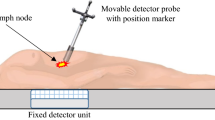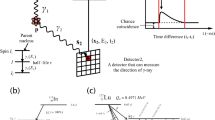Abstract
Objective
When employing F-18-fluorodeoxyglucose (FDG)-guided surgery to detect positron accumulation in isolated small organs, sampling these organs from opposite directions is a useful way of determining a tumor’s position, similar to sampling a small organ with tweezers. The coincidence method is suitable for this purpose because only the positrons between two detectors can be detected. For this purpose, we developed a tweezers-type coincidence imaging detector.
Methods
The detector employs two depth-of-interaction (DOI) detectors positioned at the tip of the tweezers and images the positron distribution between them using the coincidence method. The DOI detector consists of a 4 × 3 Gd2SiO5:Ce (GSO) array optically coupled to a one-dimensionally arranged quad-photomultiplier tube. These GSOs were arranged to form a DOI detector using the Anger principle. The useful field of view is 20 mm × 15 mm. With these configurations, we could resolve 4 × 3 GSO arrays on a position histogram.
Results
Because the imaging detectors were positioned at the tip of the tweezers, one could easily sample the target part manually from opposed sides. A real-time image in coincidence between these two DOI detectors could be obtained. The point spread functions were approximately 3-mm full width at half-maximum (FWHM) parallel to the tweezers and 4-mm FWHM perpendicular to them. The sensitivity was ∼1% when the two imaging detectors were 10 mm apart.
Conclusions
With these results, we conclude that the developed tweezers-type imaging detector has a potential to be a new instrument in nuclear medicine
Similar content being viewed by others
References
Desai DC, Arnold M, Saha S, Hinkle G, Soble D, Fry J, et al. Correlative whole-body FDG-PET and intraoperative gamma detection of FDG distribution in colorectal cancer. Clin Positron Imaging 2000;3:189–194.
Essner R, Hsueh EC, Haigh PI, Glass EC, Huynh Y, Daghighian F. Application of an F-18-fluorodeoxyglucosesensitive probe for the intraoperative detection of malignancy. J Surg Res 2001;96:120–126.
Zervos EE, Desai DC, Depalatis LR, Soble D, Martin EW. F-18-labeled fluorodeoxyglucose positron emission tomography-guided surgery for recurrent colorectal cancer: a feasibility study. J Surg Res 2001;97:9–13.
Hoffman EJ, Tornai MP, Janecek M, Patt BE, Iwanczyk JS. Intraoperative probes and imaging probes. Eur J Nucl Med 1999;26:913–935.
Levin CS, Tornai MP, MacDonald LR, Hoffman EJ. Annihilation gamma ray background characterization and rejection for a small beta camera used for tumor localization during surgery. IEEE Trans Nucl Sci 1997;44:1120–1126.
Tornai MP, Levin CS, MacDonald LR, Holdsworth CH, Hoffman EJ. A miniature phoswich detector for gamma-ray localization and beta imaging. IEEE Trans Nucl Sci 1998;45:1166–1173.
Raylman RR. Performance of a dual, solid-state intraoperative probe system with F-18, Tc-99 m, and In-111. J Nucl Med 2001;42:352–360.
Yamamoto S, Tarutani K, Minato K, Matsumoto K, Sakamoto S, Senda M. Development of a positron intraoprative detector with background rejection capability. Ann Nucl Med 2005;19:23–28.
Yamamoto S, Higashi T, Matsumoto K, Senda M. Preliminary study for the development of a tweezers-type coincidence detector for tumor detection. Nucl Instrum Methods Phys Res A 2005;548:564–570.
Yamashita T, Uchida H, Okada H, Kurono T, Takemori T, Watanabe M, et al. Development of a high resolution PET. IEEE Trans Nucl Sci 1990;37:594–599.
Murayama H, Ishibashi H, Uchida H, Omura T, Yamashita T. Depth encoding multicrystal detector for PET. IEEE Trans Nucl Sci 1998;45:1152–1157.
Weber MF, Strharsky RJ, Stover CA, Nevitt TJ, Ouderkirk AJ. Giant birefringent optics in multilayer polymer mirrors. Science 2000;287:2451–2456.
Yamamoto S, Matsumoto K, Senda M. Development of a positron/single-photon imaging detector. Phys Med Biol 2006;51:457–469.
Author information
Authors and Affiliations
Corresponding author
Rights and permissions
About this article
Cite this article
Yamamoto, S., Sakamoto, Y., Matsumoto, K. et al. Development of a tweezers-type coincidence imaging detector. Ann Nucl Med 22, 387–393 (2008). https://doi.org/10.1007/s12149-008-0114-7
Received:
Accepted:
Published:
Issue Date:
DOI: https://doi.org/10.1007/s12149-008-0114-7




